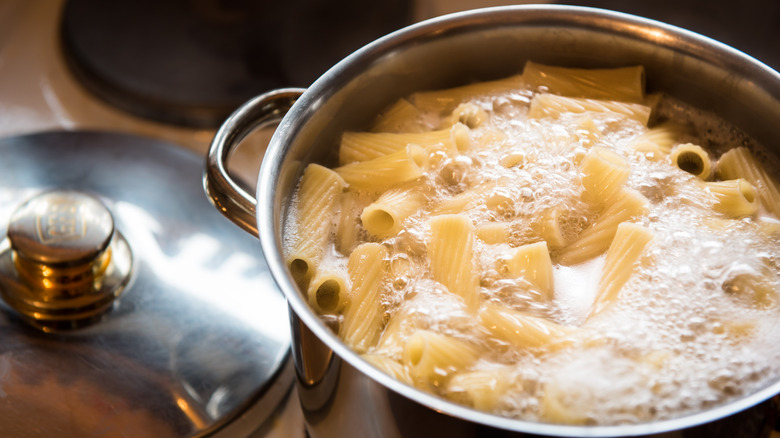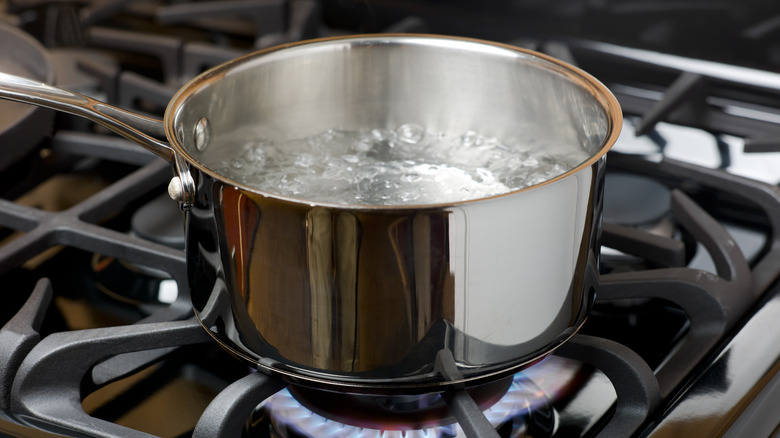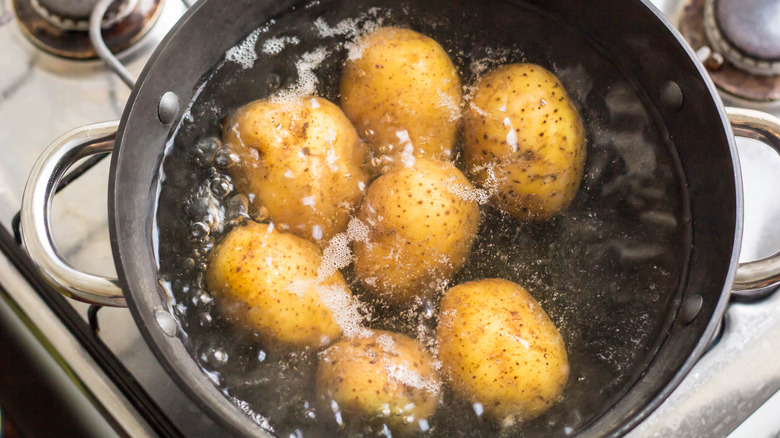The Best Uses For Simmering Vs. Boiling Water
Oftentimes when cooking, many of us can become impatient while waiting for boiling water to speed up and might mistakenly think of simmering and boiling as interchangeable states — after all, how much of a difference can bubbles make? Turns out, a lot. If you find yourself stuck with gummy and sticky pasta rather than a perfectly al-dente batch, for example, you may have fallen for the all too common simmer-is-the-same-as-boil pitfall.
At its simplest, the difference between the two lies in the temperature of the water. Whereas boiling water requires a temperature of 212 degrees Fahrenheit (100 degrees Celsius), simmering happens at a comparatively lower range between 195 to 211 degrees Fahrenheit (90 to 99 degrees Celsius). Another cue is to look at what's going on in the pot: Boiling water has larger bubbles that roll through the water more furiously whereas simmering water has smaller, more gentler bubbles that release tendrils of steam in the air.
While the difference between the two states is visually noticeable, the effect on food is less obvious at first, but there are guidelines that are helpful to know. Where boiling is better for blanching and cooking grains, a simmer is what you want for low-and-slow cooking.
When to let water fully boil
Boiling water tends to be more hot and aggressive, which means it's generally better for quick cooking processes rather than more gentle and delicate preparations. The high temperature of boiling water is excellent for blanching vegetables that need a quick flash of heat to stop the enzymes from affecting their flavor, color, and texture. Boiling water will help vegetables retain their vivid color and flavor while getting rid of that sharpness that typically laces raw veggies. Plus, boiled water (unlike simmered) is what will make the skin come right off of salmon when it's poured over a fillet.
A rolling boil is also what you want from your water when you're cooking any pasta or grains, as well as when you're making eggs or boiling bagels before baking them. The temperature of boiling water will cook grains more quickly and the intense bubbling will agitate the water just enough to keep the pasta from sticking together into gluey lumps. The same agitation, however, can cause more delicate foods to disintegrate, and those are better left to the gentler waters that come with simmering.
When to use simmering water for cooking
While boiling water is excellent for blanching veggies and cooking things like pasta, a good simmer is what you want for practically everything else, particularly meat. Simmering water is excellent for making stocks because its temperature is high enough to break through the cartilage of meat bones and release collagen, but not so hot and bubbly that it makes the liquid cloudy.
Simmering water is better for braising tougher meats as well: Whereas boiling water can alter the protein into an unappetizing leathery texture, simmering water is gentle but hot enough to melt the collagen into gelatin, resulting in a more tender and juicier piece of meat. The low-and-slow cooking method that comes with simmering water can also extract more flavor out of ingredients, making it ideal for soups, sauces, and concentrated liquids.
That said, while all boiling water looks much the same, simmering water is more nuanced and can come in three stages: slow, regular, and rapid. A slow simmer has little to no bubbles and is ideal for braising meats and making stocks; the calmer bubbles of mid-range simmering water are what you want for soups and sauces; the close-to-boiling rapid simmer is excellent for reducing sauces. So, even when simmering, make sure to use the right stage for your cooking.



